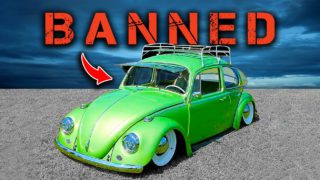These mechanical leviathans redefined what power meant during an era when engineering challenges were solved with displacement, not electronics. While today’s engineers chase efficiency, there was a time when the solution to every automotive problem was gloriously, unapologetically simple: more cubic inches.
According to experts like Hemmings, these behemoths were statements of engineering audacity that transformed transportation forever. Each represents a moment when conventional wisdom took a backseat to imagination. Before electronic nannies and emissions equipment strangled performance, these mechanical masterpieces roamed freely, leaving nothing but vaporized rubber and dropped jaws in their wake.
24. Fiat S76 (Beast of Turin)

The Beast of Turin wasn’t misnamed. Fiat’s 1911 land speed record challenger packed a preposterous 28.5L inline-four engine—an engine larger than most modern car’s entire drivetrain packages combined. With cylinder bores measuring 190mm and a 250mm stroke, this 290-horsepower monstrosity developed power figures that seemed impossible for the era.
The behemoth generated over 2,000 lb-ft of torque at just 1,400 rpm. Its exhaust note wasn’t just loud; it redefined what sound could be, creating a roar that likely damaged hearing in three countries simultaneously. Designed to humiliate the Blitz-Benz in the speed record books, the S76 embodied a time when engineering safety meant suggesting the driver write a will before climbing aboard.
23. Packard Twin Six (Packard 9005)

In 1916, when most vehicles still operated with the mechanical sophistication of farm equipment, Packard’s Twin Six arrived with revolutionary refinement. Its 6.8L V12 engine wasn’t just large—it was a statement of American engineering capabilities during an era when European manufacturers dominated discussions of technical excellence.
This approximately 85-horsepower powerplant transformed luxury transportation through smoothness rather than outright power. While modest by today’s standards, this output arrived in an era when 20 horsepower qualified as “spirited.” The Twin Six’s impact wasn’t just mechanical—it established the multi-cylinder engine as the unquestioned hallmark of automotive prestige, beginning an engineering philosophy that continues to influence luxury vehicle development a century later.
22. Cadillac V16 (Series 452)

Launching a 7.4L V16 engine during the Great Depression required either tremendous courage or complete detachment from economic reality. In 1930, Cadillac chose the former path with the Series 452, creating an engine that remains one of history’s most audacious luxury statements.
With approximately 175 horsepower delivered with remarkable refinement, the V16 forever changed luxury expectations. Engineers created this masterpiece by essentially combining two straight-8 engines at a 45° angle, resulting in perfect balance and operation smooth enough to balance coins on edge while running. While the Depression ensured limited production, the V16 cemented Cadillac’s reputation as “The Standard of the World” for generations.
21. Rolls-Royce Phantom III

Breaking from tradition, the Phantom III embraced cutting-edge aviation technology when it debuted. Produced during a brief window from 1936 to 1939, it represented Rolls-Royce’s most advanced prewar automobile. The Phantom III utilized a sophisticated 7.3L V12 engine—a technological leap that wouldn’t be repeated until decades later.
Engineers crafted this powerplant from advanced aluminum alloy, saving considerable weight while maintaining strength. Until the 1998 Silver Seraph, this remained Rolls-Royce’s most cylinder-rich engine. Its design drew direct inspiration from the company’s Schneider Trophy-winning airplane engines, adapting aviation excellence for road use. The V12 configuration provided both the smoothness and prestige expected from Britain’s most exclusive automotive brand.
20. Bugatti Type 41 Royale

The Bugatti Royale wasn’t just large—it was automotive royalty in literal form. The legendary Royale boasted a 14.7L straight-eight engine—almost four times larger than today’s typical luxury car powerplant. Ettore Bugatti originally developed this engine for French military aircraft before adapting it for automotive use.
Its massive one-piece block featured a 4.9-inch bore and 5.1-inch stroke, producing between 275-300 horsepower at just 1,800 rpm. Only six Royales left the factory between 1926 and 1931, each requiring an astonishing 43L cooling system. With its immense proportions, the Royale wasn’t just a car—it was automotive architecture, requiring chauffeurs who understood the physics of moving something of such extraordinary scale through traffic.
19. Lincoln K Series V12

Lincoln built the K Series V12 with precision-machined components that delivered effortless power. The 1934 Lincoln K showcased a refined 6.8L V12 engine during an era when cylinder count signified prestige. It generated approximately 150 horsepower, allowing these substantial luxury vehicles to maintain highway speeds with remarkable ease.
This sophisticated powerplant initially propelled both KA and KB model variants. Lincoln simplified its branding approach in 1935, dropping individual model designations. As market trends shifted by 1939, declining demand for large luxury cars led to the engine’s retirement. The K Series V12 represented American engineering excellence during the pre-war luxury car golden age, offering Continental refinement with American reliability and serviceability. Speaking of unreliability, here are some engines you should avoid.
18. Duesenberg Model J

The Model J didn’t just raise the bar for American performance—it launched it into the stratosphere. Introduced in 1928, this engineering masterpiece established benchmarks that competitors struggled to match for decades. Its heart was a 6.9L straight-eight engine developing 265 brake horsepower—more than double what competitors offered.
This powerhouse propelled the Model J to 115 mph, a velocity that seemed impossible when most roads remained unpaved. The engine featured sophisticated double overhead camshafts and four valves per cylinder when most manufacturers used simple flathead designs. Each Model J received custom coachwork from elite designers, making every example a bespoke masterpiece. With performance claims including “The World’s Fastest Production Car,” the Duesenberg became synonymous with ultimate automotive achievement.
17. Mercedes-Benz 770

Few automobiles commanded respect like the imposing Mercedes-Benz 770 of the 1930s-1940s. This flagship model featured a magnificent 7.7L straight-eight engine that epitomized German engineering excellence. The standard version produced 155 horsepower, while supercharged “Kompressor” variants delivered approximately 230 horsepower—extraordinary figures for the era.
The engine’s massive size and torque output enabled effortless high-speed cruising—a crucial requirement for its intended clientele. Even on challenging mountain roads, the 770 maintained composure and stability that smaller vehicles couldn’t match. Its engineering depth and material quality made it the preferred transportation for heads of state and industrial leaders across Europe. The 770’s presence announced authority before its passengers even exited the vehicle.
16. Chrysler Hemi 426

Automotive enthusiasts immediately recognize the legendary Chrysler Hemi 426. This 7.0L V8 engine burst onto the scene in 1964, revolutionizing American performance expectations. Nicknamed “elephant” for its size and weight, it dominated NASCAR racing with such overwhelming superiority that officials changed regulations specifically to curb its advantage.
Street production lasted from 1966 to 1971, creating an almost mythical reputation. Its hemispherical chambers allowed larger valves and optimized fuel mixture ignition, generating substantial horsepower and torque. The Hemi cemented its place in automotive history through muscle car icons like the Charger and Barracuda. No engine better represents the golden age of American performance when stoplight drag races settled more neighborhood disputes than lawyers ever could.
15. Chevrolet 454 Big Block V8

The 1970 Chevelle SS 454 creates a visual presence matching its performance promises. Its functional cowl induction hood feeds crucial air to the 7.4L powerhouse beneath. In LS6 form, this engineering marvel delivers 450 horsepower and pavement-wrinkling 500 lb-ft of torque.
Chevrolet’s deep-skirt block design and four-bolt main bearing caps ensure durability even when modified. Chrome valve covers with “454” emblems became instant status symbols nationwide. Dual exhaust pipes deliver pure Americana – a thunderous rumble transforming into a war cry under acceleration. The subtle “SS 454” badging represents automotive understatement, like a nuclear submarine with a small “caution” label.
14. Ford 460

The 1973 Ford Thunderbird embodied American excess through flowing lines and hidden headlights. Beneath that expansive hood resides the 460 cubic inch (7.5L) V8 – an engine so large it challenges service access. With its 3.85-inch stroke and 4.36-inch bore, this engineering marvel balances low-end grunt with high-end power.
Ford’s engineers mounted the engine low in the chassis, improving handling despite substantial front-axle weight. The cooling system required takes up almost as much space as entire modern engines. When those dual exhaust tips emit their authoritative note, it’s Ford announcing that cubic inches still matter in luxury performance.
13. Oldsmobile Rocket 455

The 1970 Oldsmobile 442 with Rocket 455 proves muscle cars don’t need visual shouting. The W-30 performance package adds functional hood scoops feeding air to the 7.5L V8 – Oldsmobile’s evolution from the original Rocket 88. Beneath the hood, a distinctive gold and black air cleaner announces this isn’t a grocery-getter.
Output ranges from 310 to 400 horsepower with earth-moving 678 lb-ft of torque in W-30 form. Engineers gave this engine a uniquely tall deck height allowing longer connecting rods – delivering the smoothest operation of any GM big block. When those dual exhaust outlets release the Rocket’s distinctive rumble, knowledgeable enthusiasts can distinguish it from other GM offerings.
12. Pontiac 455

The 1971 Firebird Formula 455 perfectly marries aggressive styling with brute power. Under that substantial hood resides Pontiac’s engineering masterpiece – the 7.5L 455 cubic inch V8, the largest engine ever to wear Pontiac valve covers. This powerplant delivers 335 horsepower and earth-rotating 480 lb-ft of torque in standard form.
The optional Ram Air IV package adds a functional shaker hood scoop that protrudes through the hood and moves with the engine. Pontiac engineers designed the 455 with racing-grade main bearings measuring 3.25 inches for exceptional durability. While competitors focused on high-RPM horsepower, Pontiac prioritized torque production – creating a street-friendly monster that could light up tires from virtually any speed.
11. Buick 455

The 1970 Buick GSX represents the sophisticated approach to muscle car design. Under the hood resides Buick’s engineering masterpiece – the 455 cubic inch (7.5L) V8 that arrived in 1970 as the division’s largest-ever powerplant. Buick’s engineers employed advanced thin-wall casting technology, creating an engine significantly lighter than competitors despite its massive displacement.
The standard 455 generates 350 horsepower and pavement-wrinkling 510 lb-ft of torque – figures that transformed the GSX into a genuine stoplight sleeper. The Stage 1 performance package boosted output to 360 horsepower through cylinder head and camshaft modifications, though many experts believe actual output exceeded 400 horsepower. When Buick owners lined up against Chevelles, GM’s hierarchy suddenly seemed less clear.
10. Cadillac 500

The 1970 Cadillac Eldorado represented American luxury defined through engineering excess. Beneath that massive hood resides the largest production V8 ever installed in an American car – the 8.2L (500 cubic inch) engine. Initially producing 400 horsepower and 550 lb-ft of torque, this powerplant ensured the 4,800-pound Eldorado never felt underpowered.
Cadillac’s front-wheel-drive layout placed the entire engine ahead of the front axle, creating unusual weight distribution but maximizing interior space. By 1976, emissions regulations had reduced output to just 190 horsepower, though torque remained substantial enough for adequate performance. Even in neutered form, the 500 cubic inch designation retained bragging rights no competitor could match.
9. Lincoln 462

The 1967 Lincoln Continental represents minimalist design creating maximum impact. Its clean, slab-sided panels with minimal ornamentation create an instantly recognizable silhouette. The suicide doors became the car’s signature, making entrance and exit an event. Under that hood resided the Lincoln 462 cubic inch engine that debuted in 1966, demonstrating Lincoln’s commitment to performance luxury.
This sophisticated powerplant developed 340 horsepower and 485 lb-ft of torque, ensuring Continental owners never lacked passing power despite the car’s 5,000+ pound weight. Lincoln incorporated hydraulic valve lifters that eliminated periodic adjustments and an advanced aluminum four-barrel carburetor. Every engineering decision prioritized remarkable smoothness at all speeds – perfectly matching Lincoln’s luxury positioning.
8. Isotta Fraschini Tipo 8A

The 1924 Isotta Fraschini Tipo 8A stands as automotive aristocracy from an era of handcrafted excellence. Each chassis received custom coachwork from legendary firms like Castagna or Fleetwood, creating automotive artwork rather than mere transportation. Powering this masterpiece was a 7.3L straight-8 engine producing between 115 and 160 metric horsepower – remarkable figures for the 1920s.
The inline-8 configuration provided exceptional smoothness, critical for a luxury automobile commanding $20,000 in 1924 (equivalent to over $325,000 today). The engine’s enormous size required an exceptionally long hood, creating dramatic proportions coachbuilders exploited to create breathtaking designs. Multi-tone paint schemes and hand-formed chrome accents ensured wealthy owners never encountered their exact automobile at social gatherings.
7. Bentley 8 Litre

The 1931 Bentley 8 Litre represents W.O. Bentley’s ultimate expression before Rolls-Royce acquisition. The massive chassis accommodated custom coachwork ranging from formal limousines to sporting saloons, all sharing the commanding presence created by that massive radiator grille. Beneath the bonnet resided Bentley’s engineering masterpiece – a 7.9L inline-6 generating between 200-220 horsepower when Ford’s V8 produced barely 65.
This powerplant featured advanced technology including dual ignition systems with separate distributors, an automatic radiator shutter for optimal temperature control, and servo-assisted brakes. With only 100 examples produced during 1930-1932, the 8 Litre created instant exclusivity. These technological advancements enabled the massive luxury car to reach speeds approaching 100 mph – extraordinary for a vehicle wearing formal coachwork.
6. Marmon 516

The 1932 Marmon Sixteen represents the ultimate expression of American pre-war luxury engineering. Its elegant LeBaron-clothed body features flowing fenders and perfectly balanced proportions despite the massive engine requiring substantial hood length. Powering this masterpiece is the Marmon 516 – a 45-degree V16 engine displacing 491 cubic inches (8.0L) and generating 200 horsepower in 1932 when most vehicles struggled to produce half that figure.
Howard Marmon constructed this mechanical jewel primarily from aluminum alloy with steel cylinder liners, reducing weight while maintaining durability decades before aluminum engines became commonplace. The engine’s size necessitated the car’s long hood, which designers transformed into a styling advantage. With fewer than 400 examples built, these rolling masterpieces now command seven-figure prices at auction.
5. Cadillac 472

The 1970 Cadillac DeVille embodies American luxury through generous proportions and engineering excellence. Beneath that expansive hood resides Cadillac’s 472 cubic inch (7.7L) V8 that established new benchmarks in the luxury segment. Engineers specified a 4.3-inch bore with a 4.06-inch stroke, creating excellent low-end torque characteristics perfect for moving substantial sedans with authority.
The engine generates 375 horsepower and 525 lb-ft of torque – ensuring even Cadillac’s heaviest models accelerate with dignified authority. The DeVille’s massive front overhang accommodates the engine while creating long-hood, short-deck proportions that signified luxury in American design. Innovative engineering reduced part count by 10% compared to previous designs while decreasing potential leak points with 25% fewer gasketed joints.
4. Lincoln 430 MEL V8

The 1963 Lincoln Continental demonstrates how restraint creates timeless design. Those clean, slab-sided panels with minimal ornamentation remain instantly recognizable nearly six decades later. The suicide doors create a massive opening when both front and rear doors open, facilitating elegant entry and exit. Under that hood resides Lincoln’s 430 cubic inch (7.0L) MEL V8, representing a revolutionary approach to American engine design.
Engineers specified a 4.30-inch bore with a 3.70-inch stroke, creating an engine emphasizing smoothness and low-end power – perfect for luxury applications. The Continental’s front end features a distinctive grille and hidden headlights maintaining clean lines when not used, while the trunk lid displays a subtle raised section reminiscent of the iconic Continental spare tire hump – connecting to heritage without resorting to pastiche.
3. Chrysler 440

The 1969 Dodge Charger R/T represents muscle car design at its zenith, with that distinctive fastback roofline creating an instantly recognizable silhouette. Beneath the hood resides the formidable Chrysler 440 cubic inch (7.2L) V8 engine – designed for everyday drivability while maintaining excellent performance credentials, creating perhaps the ideal balance for real-world use.
The “Six Pack” version features three two-barrel carburetors, producing 390 horsepower and 490 lb-ft of torque. The R/T package adds functional hood scoops and heavy-duty suspension components. The 440’s reputation for durability stems from robust design – thick cylinder walls, forged internals, and superior oiling system make it nearly bulletproof under hard use. While the Hemi received magazine coverage, knowledgeable enthusiasts often chose the 440 for superior streetability and easier maintenance.
2. Rolls-Royce Silver Cloud

The 1962 Rolls-Royce Silver Cloud III epitomizes British luxury through perfect proportions rather than excessive ornamentation. That stately silhouette, hand-crafted body panels, and iconic Pantheon grille topped by the Spirit of Ecstasy mascot create immediate recognition. For the Silver Cloud 2 and 3 models, Rolls-Royce abandoned their traditional straight-six in favor of a 6.2L V8 engine – a significant engineering shift for the conservative British manufacturer.
This powerplant improved performance by approximately 20% while maintaining the marque’s famous smoothness and refinement. The Silver Cloud’s exterior features integrated headlights replacing previous fender-mounted units, subtle curves rather than sharp angles, and restrained chrome accents highlighting the body’s elegant lines. Dual exhaust outlets emit virtually no sound at idle and only a distant purr at cruising speeds – precisely what customers expected from Britain’s premier luxury manufacturer.
1. Chrysler 413

The 1963 Chrysler 300J represents American performance luxury before muscle cars monopolized the high-horsepower conversation. Under that hood resides the potent Chrysler 413 cubic inch (6.8L) V8 – a key member of Chrysler’s Raised Block family that would later include the 426 Hemi and 440 Magnum.
When introduced in 1959, this powerplant represented the largest engine available in American production cars. In “Golden Lion” configuration, the 413 produces 390 horsepower and 485 lb-ft of torque thanks to cross-ram induction with twin four-barrel carburetors mounted on long intake runners. The 300’s exterior features minimal chrome, letting clean body lines and subtle performance cues like the discreet rear decklid spoiler communicate its sporting intentions.





























